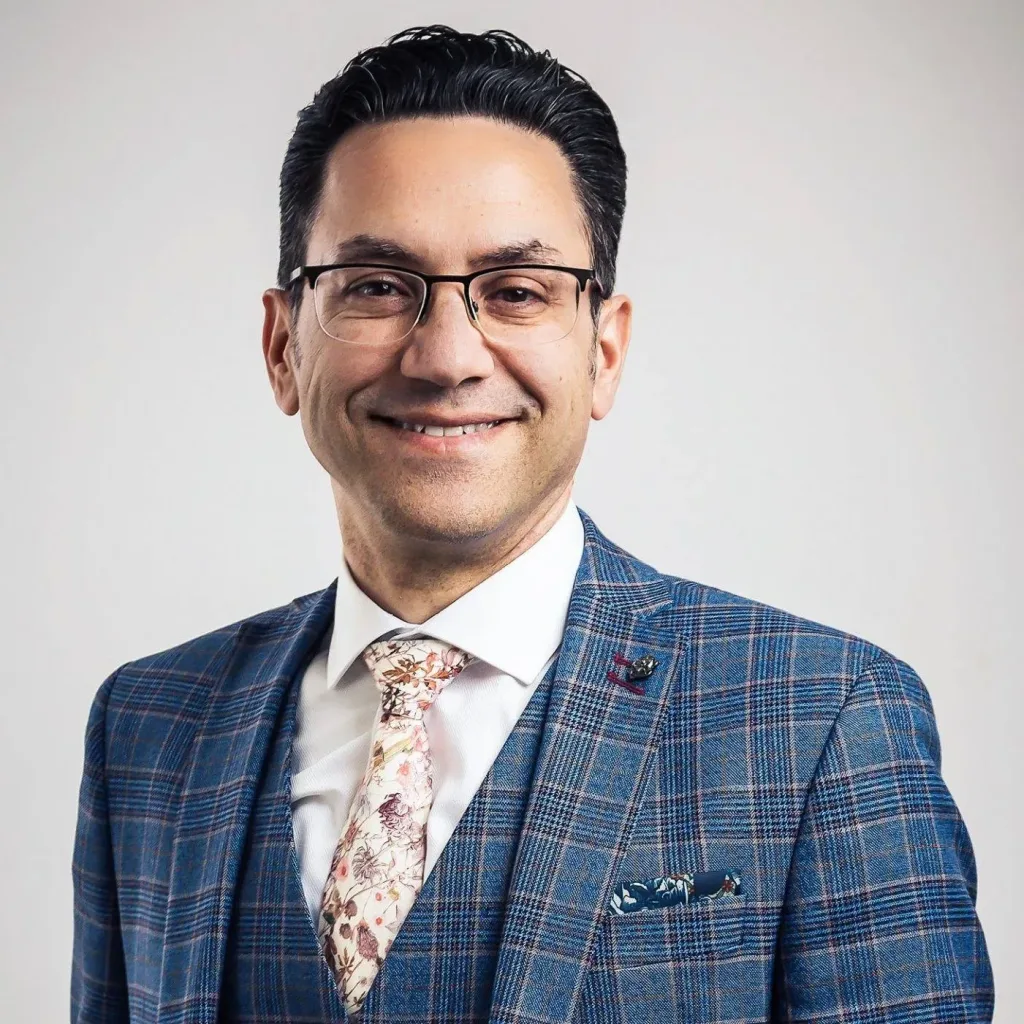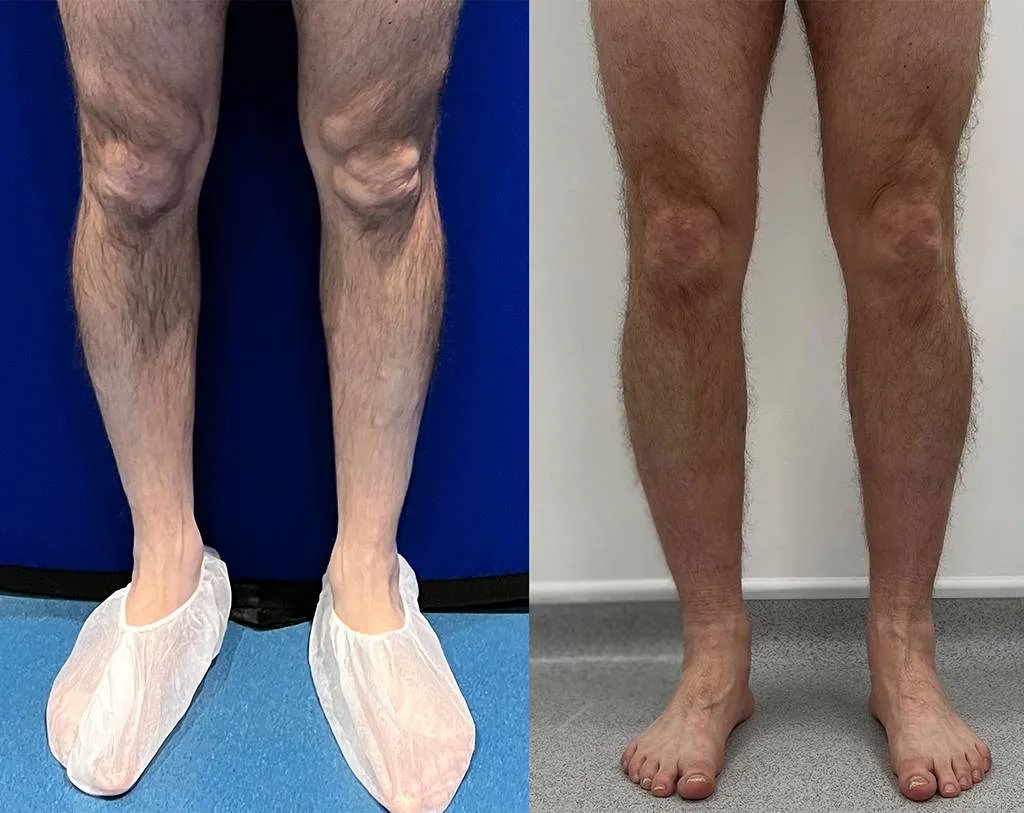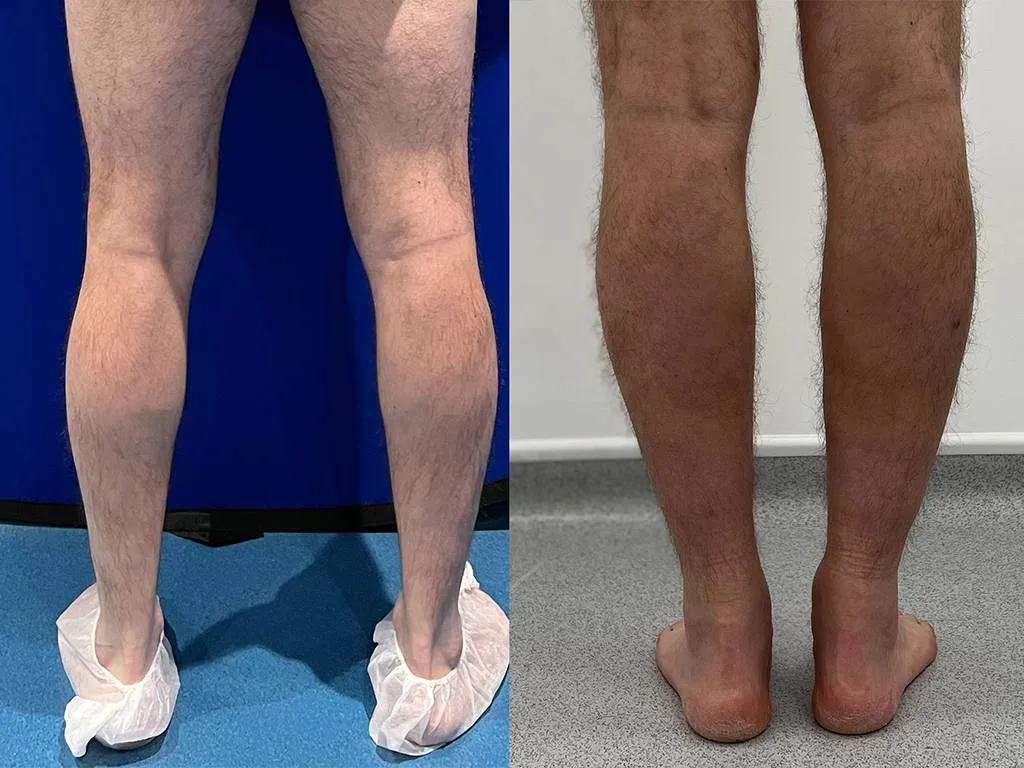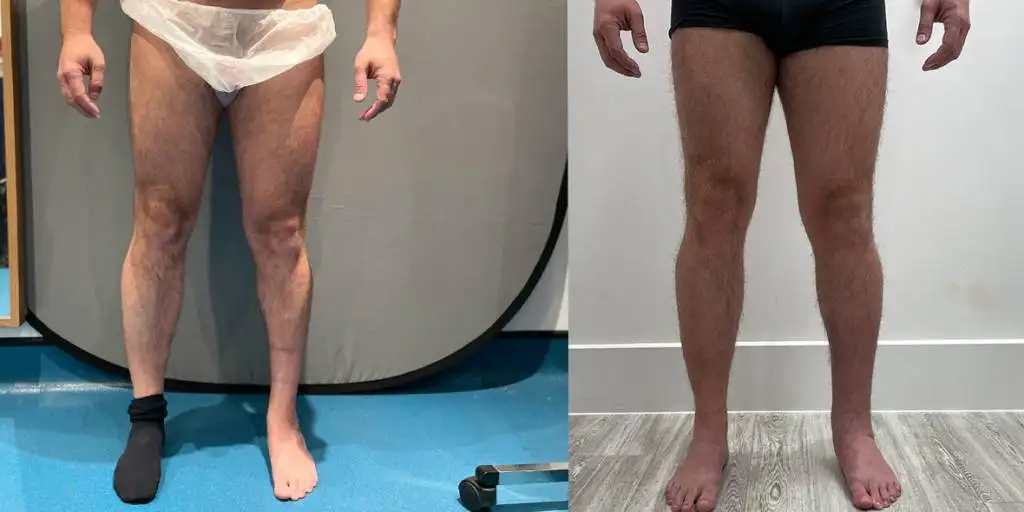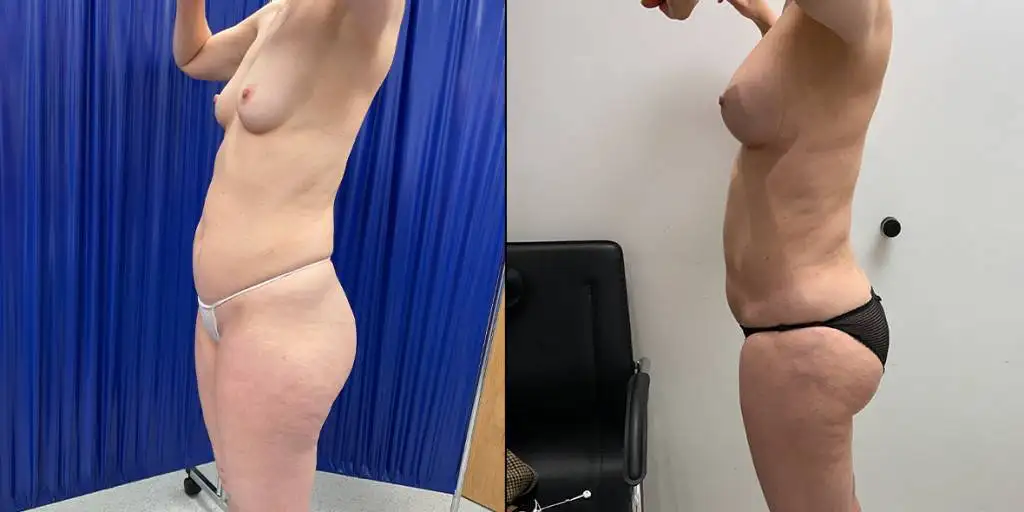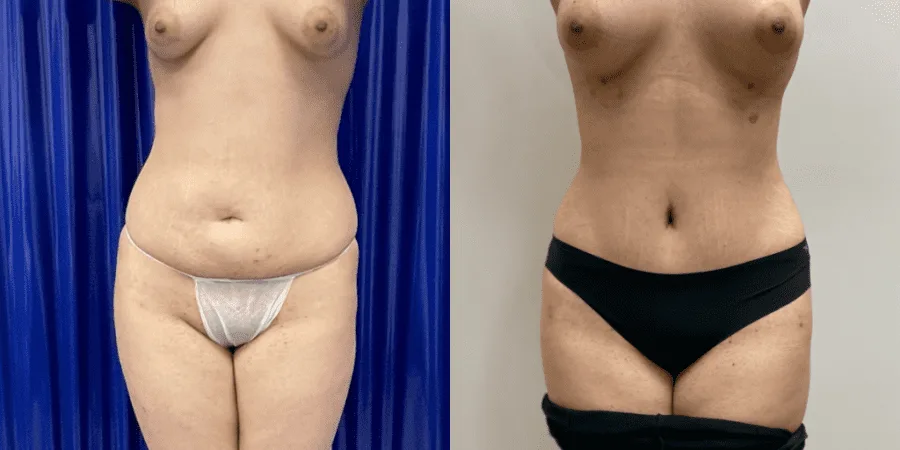What Is Fat Transfer?
Fat transfer, also known as fat grafting or lipofilling, is a surgical procedure that transfers fat from one part of the body to another using liposuction. Fat transfer procedures can be used to contour areas like the breasts, buttocks, and calves, and sculpt areas like the abdomen, thighs, upper arms, and back.
Fat transfer uses your own fat cells to enhance your figure, as opposed to foreign implants that pose a risk of allergic reactions. The results from fat transfer are more subtle and natural-looking, both in appearance and to the touch.
As one of the UK’s leading experts in fat transfer, Dr. Omar Tillo not only performs this procedure as one of his top specialties, but also teaches advanced techniques to BAPPS-accredited plastic surgeons. Using his expertise in the field, he is able to create subtle, natural-looking enhancements that complement your unique shape with precision and artistry.
Contact us today for more information about having a fat transfer in London.
Everything You Need To Know About the Fat Transfer Procedure
Treatments
1Results
4-6 monthsAnesthesia
Sedation or GeneralSurgery Time
1-4 HoursHospital Time
2-6 HoursMobility
12 HoursWashing
3 DaysOff-Work
10 DaysExercise
4 WeeksFull Recovery
6 WeeksRealSelf Patient Reviews
Read real CREO Clinic patient reviews of Dr. Tillo’s work on fat transfer procedures, including breast augmentation and Brazilian butt lifts.
Before & After Fat Transfer Procedures
Why Choose CREO Clinic for Fat Transfer in London?
Dr. Omar Tillo at CREO Clinic in London has extensive experience in fat grafting procedures, having performed hundreds of procedures on multiple parts of the body using a myriad of liposuction technologies and surgical techniques. He is particularly renowned for his unique and safe approach to using fat grafting for Brazilian Butt Lift (BBL) and breast augmentation procedures.
Fat transfer can also be used to enhance other areas, such as the hips, calves and hands. If you are interested in enhancing your body with the power of fat transfer, contact our team today.
Benefits of Fat Transfer
Fat transfer is a cosmetic procedure that has several benefits for the patient:
- Contouring the body – Fat transfer removes excess fat tissue from parts of the body where it’s unwanted and places it in a part of the body the patient wishes to augment. As a result, the surgery contours multiple areas of the body simultaneously.
- Treats stubborn fat – Liposuction can remove stubborn pockets of fat that have been resistant to diet and exercise to use for fat transfer.
- Uses autologous fat – The patient’s own fat cells are used, which mitigates the risk of an allergic reaction. This also benefits patients by reducing downtime in comparison to other more invasive surgical procedures, for example implants.
- Long-lasting results – In contrast to dermal fillers, which you need to repeat every 12-18 months, the results produced by a fat transfer is long-lasting.
- Managing skin conditions – Small amounts of fat transfer can be used to treat medical conditions such as scleroderma and hemifacial atrophy.
- Scar treatment – Nano fat transfer can be used to drastically improve the appearance of scars, utilising stem cells in the fat cells to rejuvenate the skin’s quality and texture.
Who is An Ideal Candidate for A Fat Transfer Procedure?
A fat transfer is ideal for patients who have excess fat in one area of the body – for example, the hips, abdomen, or thighs – and lack volume in other parts of the body.
Typically, patients undergo a fat transfer between the ages of 30 and 65, as this is when they begin to notice signs of ageing and loss of volume in areas of the body. Furthermore, patients need to have no underlying medical conditions.
In general, patients in good health with a BMI below 30, who have sufficient fat deposits to augment the targeted transfer areas are good candidates for the fat transfer procedure.
During your consultation, our surgeon will complete a full assessment to determine your suitability for the procedure and whether a fat transfer is the best solution for your cosmetic concerns.
How Much Does Fat Transfer Cost in the UK?
In general, prices for treating one area of the body with fat transfer from one liposuction area in the UK start from £8,500 at CREO Clinic.
The exact cost of a fat transfer procedure varies depending on a range of factors, including the number and size of areas requiring liposuction and fat transfer, the surgical complexity of the procedure, the estimated time in theatre and the technologies used. Therefore, you will receive an exact quote for your fat transfer following a consultation with Dr. Tillo. We’ll also discuss financing options available to you.
Target Areas for a Fat Transfer
A fat transfer surgery usually involves placing fat in the following areas of the body:
Face
A facial fat transfer corrects the loss of volume and skin elasticity that accompanies the ageing process. Facial fat grafting involves transferring fat into sunken areas of the face, such as the cheeks and jawline. In doing so, the transferred fat cells can improve the appearance of wrinkles, saggy skin, and restore lost volume to the contours of the face.
Breasts
The breasts can sag and lose their volume due to ageing, pregnancy, and weight loss. A breast augmentation with fat transfer can add volume to, and enhance the breasts without the need for breast implants. During an individual fat transfer procedure, patients can enjoy an increased volume of up to one cup size. This procedure can then be repeated if they wish to increase the size further.
In addition, patients who wish to correct the loss of volume and sagginess in the breasts can combine a fat transfer with breast lift surgery.
Buttocks
A fat transfer to the buttocks is commonly known as a Brazilian butt lift (BBL). A BBL is ideal for patients who wish to enhance their buttocks and hips by adding volume to the area, while contouring surrounding areas of the body with liposuction. This minimally invasive procedure can help to correct the appearance of hip dips and is a more natural solution for enhancing the buttocks without the use of butt implants.
Dr. Tillo is a key opinion leader on Brazilian butt lift surgery, having developed a technique known as Buttock Enhancement and Superficial Transfer of Fat (BEST-F). CREO Clinic is the only clinic in the UK using the BEST-F approach, which is a safer alternative to the traditional Brazilian butt lift that also provides the patient with a natural yet noticeable enhancement and reshaping of the bottom.
Hands
The hands are often the first area of the body to show signs of ageing as the loss of fat leads to flaccid skin, visible veins, and a change in texture. Using micro fat transfer, injecting a small amount of fat into the hands adds volume to the area in order to disguise these signs of ageing. Nano fat transfer can also be used to restore youthfulness and a rejuvenated appearance.
Calfs
Transferring fat to the calves can restore proportion and definition to legs that require enhancement. Many patients struggle to tone their calves to their desired shape using just exercise. Therefore, a fat transfer is ideal for patients that lack curves in their calves that define the legs and ankles.
At the CREO Clinic, we also offer calf implants for patients requiring a more prominent reshaping and enhancement to their legs. Dr. Tillo will be able to advise the best option for producing your desired results.
The Stages of Fat Grafting
Fat grafting consists of two main stages: liposuction and fat transfer.
Stage 1: Liposuction
Once an anaesthetic has been administered, excess fat is harvested from a predetermined area of the body using liposuction. This involves inserting a thin cannula via a small incision.
At the CREO Clinic, we use a range of liposuction technologies, including Vaser (ultrasound-assisted liposuction), PAL (Power-Assisted Liposuction) and BodyTite (radiofrequency assisted liposuction). The fat cells are then broken up and removed before the incisions are closed. Overall, liposuction helps to tone and contour these targeted areas.
Stage 2: Fat Transfer
Afterwards, our plastic surgeon washes and purifies the harvested fat cells to separate them from blood and other fluids. Finally, we’ll inject the fat cells into the part of the body we are enhancing.
Prior to injection, the removed fat is washed and purified to separate the fat cells from blood and other fluids. Small incisions are then made in the areas requiring enhancement through which the fat is injected.
At the CREO Clinic, we maximise the safety of the fat transfer procedure by using an ultrasound to help guide fat placement and prevent any fat leaking into the muscle. Finally, the incisions are closed using medical-grade sutures.
Fat Transfer vs. Implants: Which One Is Right For You?
One alternative to a fat transfer procedure is implants. At CREO Clinic, we can insert implants into the breast, buttocks, calves, and areas of the face as an alternative solution to fat transfer. While both treatments can enhance and augment the targeted areas of the body, there are significant differences between fat transfer vs. implants:
| Fat Transfer | Implants | |
| Results | Subtle enhancement to one area of the body, tones another area by removing fat | Substantial enhancement to treatment area |
| Anaesthetic | Sedation or General (standard)Local (Micro/Nano) | General |
| Scarring | Minimal | Noticeable at incision sites |
| Recovery | 4-6 weeks | 6 weeks |
| Longevity | Permanent | Permanent |
| Price | Dependent on area treated, typically cheaper than implants | Typically more expensive than fat transfer |
What Are The Potential Risks of Fat Transfer?
At the CREO Clinic, we try to minimise risk as much as possible by working with specialists in fat transfer and adhere to the safest practice guidelines at all times. However, like any surgical procedure, there are some risks associated with fat transfer, including:
- Wound infections or poor wound healing
- Reactions to anaesthetics used
- Fat necrosis
- Asymmetry
- Seroma or haematoma
- Poor fat graft take
What To Expect Before and After the Procedure?
Your Initial Consultation
During your initial consultation, you will be asked about your expectations for fat transfer, and what a realistic outcome from the procedure is likely to be. Your medical history will also be discussed to determine your suitability for surgery and identify any potential risk factors.
Leading Up to the Procedure
Prior to a fat transfer procedure, you will need to take several steps to be prepared for surgery:
- BMI – You will need to maintain a BMI under 30 to reduce the risk of complications during and after surgery.
- Oestrogen Contraceptives/HRT – If you take the oral contraceptive pill or HRT, you will need to stop this 4 weeks before surgery to reduce the risk of thrombosis. Therefore, you will need to use alternative contraceptives during this time.
- Smoking – You will need to cease all nicotine use, including vaping and patches, four weeks before surgery as this can cause complications.
- Alcohol – Reduce your alcohol intake to ensure your body is able to heal effectively after surgery.
- Prepare your home for recovery – Make sure you have plans in place for childcare and pet care, as well as making your home as comfortable as possible for your recovery.
Day of the Surgery
On the day of your fat transfer procedure, you should get to the hospital at least an hour before surgery to allow time to complete any paperwork and pre-surgical checks. You should bring a list of any medication you are currently taking, as well as comfortable, loose clothing to wear after surgery.
The Recovery Process
After fat transfer surgery, you will spend some time in hospital waking up from the anaesthetic or sedative. Fat transfer is typically a day case procedure, but you may need to stay in hospital overnight if deemed necessary by your surgeon. The incision sites will be covered with small dressings, and you will be shown how to care for your wounds before leaving hospital. You will also need to be accompanied home with a family member or friend who can stay with and care for you for at least the first 24 hours.
As you recover from fat transfer surgery, you may experience swelling and bruising, which should gradually dissipate over the following two weeks. After this period, patients are able to resume most of their daily activities, including going back to work. However, it may take a few more weeks for the swelling to completely subside.
Fat Transfer Results
Following the fat transfer surgery, you will notice that the liposuction zones are more contoured, and that the fat transfer areas are enhanced. However, your body absorbs around 20-50% of the fat that’s injected into the treatment area. As a result, your surgeon will take this into account when determining the amount of fat to be injected.
However, you will need to wait for all post-surgical swelling to dissipate and for the fat grafts to stabilise before you can enjoy the final results of your surgery. In general, this takes up to 4-6 months, after which you will be able to appreciate your newly enhanced figure.
Micro & Nano Fat Grafting
In addition to traditional fat transfer procedures, our patients in London may also choose micro and nano fat grafting.
Micro fat grafting adds small amounts of volume to targeted areas of the body. These fat cells are collected via liposuction and are injected via smaller incisions, meaning scarring is minimal. Micro fat grafting can help alleviate common cosmetic concerns such as sagging skin and fine lines and wrinkles. Patients may choose to undergo micro fat transfer in areas such as the hands, neck and decolletage, where these aesthetic problems are most noticeable.
Nano fat transfer involves mixing fat at a cellular level to utilise the fat’s stem cells for skin rejuvenation. When injected, the stem cells can improve the texture, firmness and general appearance of the skin. In addition, nano fat transfer can be used to target particular cosmetic concerns such as scarring.
Fat Transfer FAQs
Should I lose weight before a fat transfer?
How long do fat transfer results last?
Can you receive a fat transfer after breast augmentation?
Can fat move after grafting?
What happens if you gain weight after a fat transfer?
However, more significant weight gain can cause the fat cells that have been transferred, as well as fat in the rest of your body, to increase in size, impacting the final results of your surgery. Therefore, you should aim to maintain a stable weight following your fat transfer.
Does fat transfer to the breasts cause lumps?
Is fat transfer painful?
Is fat transfer worth it?
The treatment is growing in popularity in the UK, particularly due to its versatility: not only does a fat transfer augment underdeveloped areas, but it can remove excess fat that’s resistant to diet and exercise from other parts of the body.
In addition, a fat transfer has a few advantages over other cosmetic treatments: in contrast to dermal fillers, a fat transfer delivers permanent volume; in contrast to implants, a fat transfer is a more organic solution that utilises the body’s natural fat.

